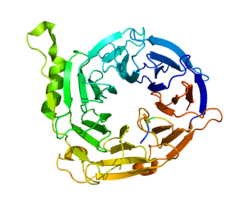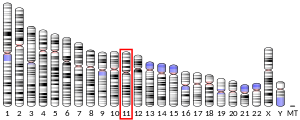EED (タンパク質)
EED(embryonic ectoderm development)は、ヒトではEED遺伝子によってコードされているタンパク質である[5][6][7]。
機能
編集EEDは、ポリコーム群タンパク質(PcG)の一員である。PcGファミリーのメンバーは多量体タンパク質複合体を形成し、複数の細胞世代にわたって持続する転写抑制状態の維持に関与している。このタンパク質は、EZH2、β7インテグリンの細胞質テール、HIV-1のMAタンパク質、そしてヒストン脱アセチル化酵素と相互作用する。このタンパク質は、ヒストンの脱アセチル化を介して遺伝子活性の抑制を媒介し、またインテグリンの機能の特異的調節因子として機能する可能性もある[7]。
臨床的意義
編集相互作用
編集EEDは次に挙げる因子と相互作用することが示されている。
出典
編集- ^ a b c GRCh38: Ensembl release 89: ENSG00000074266 - Ensembl, May 2017
- ^ a b c GRCm38: Ensembl release 89: ENSMUSG00000030619 - Ensembl, May 2017
- ^ Human PubMed Reference:
- ^ Mouse PubMed Reference:
- ^ a b “The human WD repeat protein WAIT-1 specifically interacts with the cytoplasmic tails of beta7-integrins”. J. Biol. Chem. 273 (42): 27459–66. (Nov 1998). doi:10.1074/jbc.273.42.27459. PMID 9765275.
- ^ “The murine Polycomb-group gene eed and its human orthologue: functional implications of evolutionary conservation”. Genomics 54 (1): 79–88. (Jan 1999). doi:10.1006/geno.1998.5509. PMID 9806832.
- ^ a b “Entrez Gene: EED embryonic ectoderm development”. 2024年11月17日閲覧。
- ^ “A novel mutation in EED associated with overgrowth”. Journal of Human Genetics 60 (6): 339–342. (Mar 2015). doi:10.1038/jhg.2015.26. PMID 25787343.
- ^ a b c “Transcriptional repression mediated by the human polycomb-group protein EED involves histone deacetylation”. Nat. Genet. 23 (4): 474–8. (Dec 1999). doi:10.1038/70602. PMID 10581039.
- ^ “Interaction of mouse polycomb-group (Pc-G) proteins Enx1 and Enx2 with Eed: indication for separate Pc-G complexes”. Mol. Cell. Biol. 18 (6): 3572–9. (Jun 1998). doi:10.1128/MCB.18.6.3572. PMC 108938. PMID 9584197.
- ^ “Point mutations in the WD40 domain of Eed block its interaction with Ezh2”. Mol. Cell. Biol. 18 (10): 5634–42. (Oct 1998). doi:10.1128/MCB.18.10.5634. PMC 109149. PMID 9742080.
- ^ “The protein phosphatase-1 (PP1) regulator, nuclear inhibitor of PP1 (NIPP1), interacts with the polycomb group protein, embryonic ectoderm development (EED), and functions as a transcriptional repressor”. J. Biol. Chem. 278 (33): 30677–85. (Aug 2003). doi:10.1074/jbc.M302273200. PMID 12788942.
- ^ “Different isoforms of PRIP-interacting protein with methyltransferase domain/trimethylguanosine synthase localizes to the cytoplasm and nucleus”. Biochem. Biophys. Res. Commun. 309 (1): 44–51. (Sep 2003). doi:10.1016/s0006-291x(03)01514-6. PMID 12943661.
関連文献
編集- “Nef: "necessary and enforcing factor" in HIV infection”. Curr. HIV Res. 3 (1): 87–94. (2005). doi:10.2174/1570162052773013. PMID 15638726.
- “HIV-1 integration: an interplay between HIV-1 integrase, cellular and viral proteins”. AIDS Rev 7 (1): 26–43. (2005). PMID 15875659.
- “The Drosophila esc and E(z) proteins are direct partners in polycomb group-mediated repression”. Mol. Cell. Biol. 18 (5): 2825–34. (1998). doi:10.1128/mcb.18.5.2825. PMC 110661. PMID 9566901.
- “Interaction of mouse polycomb-group (Pc-G) proteins Enx1 and Enx2 with Eed: indication for separate Pc-G complexes”. Mol. Cell. Biol. 18 (6): 3572–9. (1998). doi:10.1128/MCB.18.6.3572. PMC 108938. PMID 9584197.
- “Characterization of interactions between the mammalian polycomb-group proteins Enx1/EZH2 and EED suggests the existence of different mammalian polycomb-group protein complexes”. Mol. Cell. Biol. 18 (6): 3586–95. (1998). doi:10.1128/mcb.18.6.3586. PMC 108940. PMID 9584199.
- “Point mutations in the WD40 domain of Eed block its interaction with Ezh2”. Mol. Cell. Biol. 18 (10): 5634–42. (1998). doi:10.1128/MCB.18.10.5634. PMC 109149. PMID 9742080.
- “HEED, the product of the human homolog of the murine eed gene, binds to the matrix protein of HIV-1”. J. Biol. Chem. 274 (3): 1635–45. (1999). doi:10.1074/jbc.274.3.1635. PMID 9880543.
- “Transcriptional repression mediated by the human polycomb-group protein EED involves histone deacetylation”. Nat. Genet. 23 (4): 474–8. (1999). doi:10.1038/70602. PMID 10581039.
- “The polycomb group protein EED interacts with YY1, and both proteins induce neural tissue in Xenopus embryos”. Mol. Cell. Biol. 21 (4): 1360–9. (2001). doi:10.1128/MCB.21.4.1360-1369.2001. PMC 99588. PMID 11158321.
- “Histone methyltransferase activity associated with a human multiprotein complex containing the Enhancer of Zeste protein”. Genes Dev. 16 (22): 2893–905. (2002). doi:10.1101/gad.1035902. PMC 187479. PMID 12435631.
- “The protein phosphatase-1 (PP1) regulator, nuclear inhibitor of PP1 (NIPP1), interacts with the polycomb group protein, embryonic ectoderm development (EED), and functions as a transcriptional repressor”. J. Biol. Chem. 278 (33): 30677–85. (2003). doi:10.1074/jbc.M302273200. PMID 12788942.
- “Different isoforms of PRIP-interacting protein with methyltransferase domain/trimethylguanosine synthase localizes to the cytoplasm and nucleus”. Biochem. Biophys. Res. Commun. 309 (1): 44–51. (2003). doi:10.1016/S0006-291X(03)01514-6. PMID 12943661.
- “The human polycomb group EED protein interacts with the integrase of human immunodeficiency virus type 1”. J. Virol. 77 (23): 12507–22. (2003). doi:10.1128/JVI.77.23.12507-12522.2003. PMC 262565. PMID 14610174.
- “HIV-1 Nef mimics an integrin receptor signal that recruits the polycomb group protein Eed to the plasma membrane”. Mol. Cell 13 (2): 179–90. (2004). doi:10.1016/S1097-2765(04)00004-8. PMID 14759364.
- “SUZ12 is required for both the histone methyltransferase activity and the silencing function of the EED-EZH2 complex”. Mol. Cell 15 (1): 57–67. (2004). doi:10.1016/j.molcel.2004.06.020. PMID 15225548.
- “Suz12 is essential for mouse development and for EZH2 histone methyltransferase activity”. EMBO J. 23 (20): 4061–71. (2004). doi:10.1038/sj.emboj.7600402. PMC 524339. PMID 15385962.






